REAL ESTATE TOPICS
CATHERINE SHERMAN
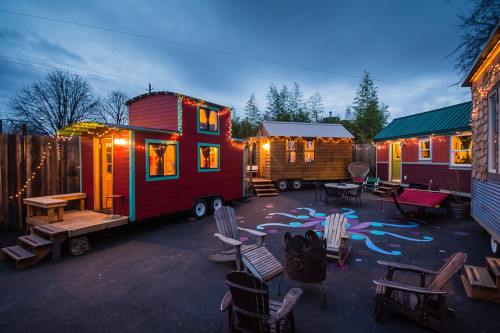
Caravan, in Portland’s Alberta Arts District, is the country’s first tiny house hotel.
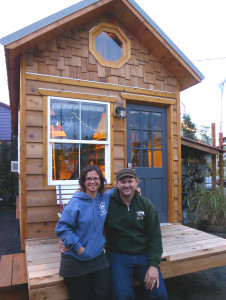
Deb Delman and Kol Peterson show off their hotel’s newest addition, Kangablue.
Deb Delman and Kol Peterson aren’t millennials, but 20-somethings are paying the couple’s bills. A year ago, they opened Caravan, the country’s first tiny house hotel, generating interest from young adults near and far.
“I’d say half of our guests are from Seattle, Portland, San Francisco and Vancouver; half are from the rest of the country; and 10-15 percent are international,” Peterson said. “We get older folks, but it’s mostly millennials who want to build their own tiny home.”
This younger generation sees the trend Jay Shafer and other tiny-home proponents started and want to join in.
“We are at a tip of a movement,” Delman said. “A high percentage [of our guests] come because they are curious to obsessed [with tiny homes].”
The tiny obsession
Saving money is top-of-mind for millennials — many of whom graduated from college in the wake of the Great Recession — but many are initially attracted to tiny homes due to their size.
“I own the 690-square-foot home next door,” Delman said. “It’s teeny but not tiny.”
A true tiny home, she says, is no more than 200 square feet and built on wheels. The size encourages, rather than limits, creativity. For example, the six tiny homes at Caravan in Portland, OR show off floor plans and features not typically found in traditional, single-family homes.
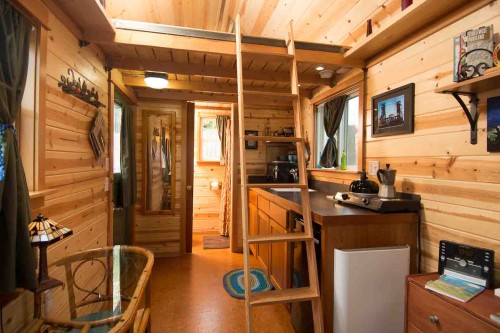
The ladder in Tandem can be moved to open up the main floor or provide access to the loft above.
“There’s a ‘cupola’ loft bed in the Caboose,” Delman said. “Tables fold, benches have storage and ladders move. There’s even a green, triangular toilet in Skyline.”
As evidenced by their names, each of the homes has a unique story as well: The Caboose is painted red and looks like a railroad car; Skyline feels sky-high with twinkle lights and an upstairs hangout zone; and Kangablue has an Australian-born builder and is lined with unusual, blue pine wood.
“A typical reaction is ‘They’re so much bigger than the pictures,’” Delman said. “People say, ‘They’re so cute and fun.’”
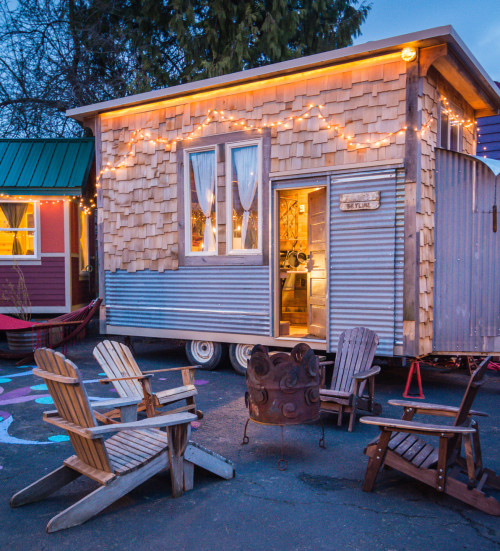
Skyline, one of the most popular tiny homes at Caravan, has curb appeal with a shed roof, metal-and-shingle siding and twinkle lights.
Not-so-tiny considerations
While the tiny-house obsession seems contagious in artsy northeast Portland, taking action is another story.
“A lot of people fantasize about building a tiny house but don’t end up doing it,” Delman said. Part of the reason is financial, but there are also several practical concerns:
- Can you afford it? While many 20-somethings can’t afford to buy a $20,000 to $60,000 tiny home outright, many are drawn to the low building costs. Carrie Lipps, a millennial working at the tiny house hotel, loves the fact that tiny homes cost around $10,000 to $15,000 for materials if you go the DIY route. When compared to a single-family residence with a 30-year mortgage, this seems like an affordable upfront investment without a lingering monthly payment.
BECOME A CALIFORNIA REAL ESTATE AGENT. CLICK LINK BELOW...
- Can you wait? As the saying goes, time is money. Peterson says tiny homes take longer to build than most people think. “You can expect three months if you have a professional builder, but realistically, tiny homes take more like a year to build,” he said. This depends on a number of factors including the builder’s skill level and the amount of detail in your design.
- Can you build it yourself? There is a lot to consider when building a tiny home, from the initial design to plumbing and electrical. Professional tiny house builder Derin Williams says younger buyers get excited, but “they’re artists not builders.” Over the past two years, he’s consulted on DIY tiny-home projects with leaking roofs, poorly designed plumbing and electrical issues. He worries that people will hurt themselves if they don’t know what they’re doing. Peterson agrees that the complexity of building a tiny home is often overlooked. While they’re smaller than a traditional single-family house, they present the same, if not more, design challenges. First, you have to think about how much weight you can have if you want your home on wheels to be portable. Then you have to think about maximizing space to allow for storage and multiple functions.
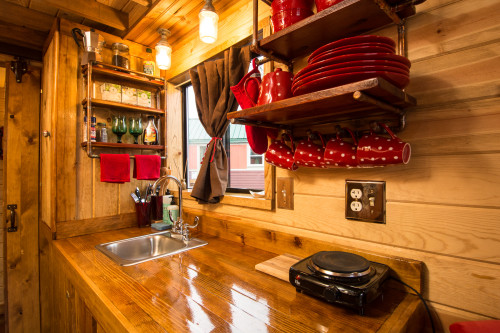
To save counter space, the Caboose kitchen has built-in shelves for storing dishes and spices.
- Do you have a place to park it? If you manage to complete the building process, the next challenge is parking. Williams said he recently consulted on three tiny homes being built and not one of the owners knows where they are going put them. Tiny homes at Caravan are parked on a piece of land the owners purchased, but not everyone has an empty lot at their disposal. Because zoning for tiny homes is a gray area in many cities, the more common solutions are parking in a friend’s backyard or driveway, or staying in a RV park.
- Do you like communal living? In part because of the parking situation, many owners of tiny homes end up getting pretty close with their neighbors. For this reason, Delman says tiny homes can work for full-time living, but it has to be a situation where you can share resources. Specifically, someone looking to invest in a home on wheels has to get permission from the city to connect to the sewer line or use a neighbor’s facilities. And beyond plumbing, a lack of storage space and utilities leads many to depend on neighbors when cooking a big meal, entertaining, hosting guests or enjoying a bubble bath. These daily amenities become a luxury when you live in less space.
- Do you enjoy living with less? Even if you are friends with your neighbors, your personal living space will not only be small, but simple. The tiny homes at Caravan have showers and kitchenettes, but not all tiny homes have these features. Some don’t even have running water. It’s important to know what level of “rustic” you can honestly live with.
While tiny homes aren’t for everyone, Delman and Peterson say they’re happy promoting the industry through their hotel.
“The single most important thing people can do to reduce their environmental footprint is to live in a smaller space,” Peterson said.

No comments:
Post a Comment
If you have questions or a comment about this Blog or our Company please use this section. We will do our best to review and answer within 24 hours.